#event: revolution 2022
Photo


credit: JJ Williams
#jon moxley#aew#aewedit#aew revolution#all elite wrestling#candids#event: revolution 2022#*#ours: edits#maker: r
106 notes
·
View notes
Text
Time for a little poll:
Please respond and spread this post as much as possible. The goal is to get as many people as possible to participate and hopefully bring attention to what's going on in Iran.
#free iran#freedom for iran#woman life freedom#women life freedom#iran protests#iran protests 2022#iran protests 2023#iran revolution#iran revolution 2022#iran revolution 2023#mahsa amini#stop executions in iran#tumblr#things we care about#current events#social justice
63 notes
·
View notes
Text

Today’s team: @cat-fishy & @sophiahoppia
Dance Dance Chocobros was written for the FFXV Reverse Bang 2022 and can be found on AO3 here.
Rating: Teen & Up
Gladnis, Hints of Gladio/Ignis/Noctis/Prompto, No Archive Warnings Apply
Description: When Gladio once again messes up the group's schedule and Ignis is close to losing his patience, Noctis and Prompto suggest settling the problem like real men: by playing Dance Dance Chocobros.
#ffxv reverse bang 2022#ffxv reverse bang#final fantasy xv#fanart#fanfiction#fandom event#brotherhood era#Gladnis#playful bickering#dance dance revolution
16 notes
·
View notes
Text

My last entry for @may-blade - I started this on May 31st for the FREE DAY and only finished it last night. Here, Tyson is contemplating some big changes in his life as he approaches the end of high school and potentially his beyblading career in my fanfic - No Sacrifice, No Victory
Read it here: https://m.fanfiction.net/s/13653885/1/No-Sacrifice-No-Victory
#mayblade 2022#mayblade#tyson granger#takao kinomiya#beybladeseason4#beyblade event#beyblade#g Revolution#steph summers
36 notes
·
View notes
Text
The hall of mirrors that Vladimir Putin has built around himself and within his country is so complex, and so multilayered, that on the eve of a genuine insurrection in Russia, I doubt very much if the Russian president himself believed it could be real.
Certainly the rest of us still can’t know, less than a day after this mutiny began, the true motives of the key players, and especially not of the central figure, Yevgeny Prigozhin, the leader of the Wagner mercenary group. Prigozhin, whose fighters have taken part in brutal conflicts all over Africa and the Middle East—in Syria, Sudan, Libya, the Central African Republic—claims to command 25,000 men in Ukraine. In a statement yesterday afternoon, he accused the Russian army of killing “an enormous amount” of his mercenaries in a bombing raid on his base. Then he called for an armed rebellion, vowing to topple Russian military leaders.
Prigozhin has been lobbing insults at Russia’s military leadership for many weeks, mocking Sergei Shoigu, the Russian minister of defense, as lazy, and describing the chief of the general staff as prone to “paranoid tantrums.” Yesterday, he broke with the official narrative and directly blamed them, and their oligarch friends, for launching the full-scale invasion of Ukraine in 2022. Ukraine did not provoke Russia on February 24, he said: Instead, Russian elites had been pillaging the territories of the Donbas they’ve occupied since 2014, and became greedy for more. His message was clear: The Russian military launched a pointless war, ran it incompetently, and killed tens of thousands of Russian soldiers unnecessarily.
The “evil brought by the military leadership of the country must be stopped,” Prigozhin declared. He warned the Russian generals not to resist: “Everyone who will try to resist, we will consider them a danger and destroy them immediately, including any checkpoints on our way. And any aviation we see above our heads.” The snarling theatricality of Prigozhin’s statement, the baroque language, the very notion that 25,000 mercenaries were going to remove the commanders of the Russian army during an active war—all of that immediately led many to ask: Is this for real?
Up until the moment it started, when actual Wagner vehicles were spotted on the road from Ukraine to Rostov, a Russian city a couple of miles from the border (and actual Wagner soldiers were spotted buying coffee in a Rostov fast-food restaurant formerly known as McDonald’s), it seemed impossible. But once they appeared in the city—once Prigozhin posted a video of himself in the courtyard of the Southern Military District headquarters in Rostov—and once they seemed poised to take control of Voronezh, a city between Rostov and Moscow, theories began to multiply.
Maybe Prigozhin is collaborating with the Ukrainians, and this is all an elaborate plot to end the war. Maybe the Russian army really had been trying to put an end to Prigozhin’s operations, depriving his soldiers of weapons and ammunition. Maybe this is Prigozhin’s way of fighting not just for his job but for his life. Maybe Prigozhin, a convicted thief who lives by the moral code of Russia’s professional criminal caste, just feels dissed by the Russian military leadership and wants respect. And maybe, just maybe, he has good reason to believe that some Russian soldiers are willing to join him.
Because Russia no longer has anything resembling “mainstream media”—there is only state propaganda, plus some media in exile—we have no good sources of information right now. All of us now live in a world of information chaos, but this is a more profound sort of vacuum, because so many people are pretending to say things they don’t believe. To understand what is going on (or to guess at it), you have to follow a series of unreliable Russian Telegram accounts, or else read the Western and Ukrainian open-source intelligence bloggers who are reliable but farther from the action: @wartranslated, who captions Russian and Ukrainian video in English, for example; or Aric Toler (@arictoler), of Bellingcat, and Christo Grozev (@christogrozev), formerly of Bellingcat, the investigative group that pioneered the use of open-source intelligence. Grozev has enhanced credibility because he said the Wagner group was preparing a coup many months ago. (This morning, I spoke with him and told him he was vindicated. “Yes,” he said, “I am.”)
But the Kremlin may not have very good information either. Only a month ago, Putin was praising Prigozhin and Wagner for the “liberation” of Bakhmut, in eastern Ukraine, after one of the longest, most drawn-out battles in modern military history. Today’s insurrection was, by contrast, better planned and executed: Bakhmut took nearly 11 months, but Prigozihin got to Rostov and Voronezh in less than 11 hours, helped along by commanders and soldiers who appeared to be waiting for him to arrive.
Now military vehicles are moving around Moscow, apparently putting into force “Operation Fortress,” a plan to defend the headquarters of the security services. One Russian military blogger claimed that units of the military, the Ministry of Internal Affairs, the FSB security service, and others had already been put on a counterterrorism alert in Moscow very early Thursday morning, supposedly in preparation for a Ukrainian terrorist attack. Perhaps that was what the Kremlin wanted its supporters to think—though the source of the blogger’s claim is not yet clear.
But the unavoidable clashes at play—Putin’s clash with reality, as well as Putin’s clash with Prigozhin—are now coming to a head. Prigozhin has demanded that Shoigu, the defense minister, come to see him in Rostov, which the Wagner boss must know is impossible. Putin has responded by denouncing Prigozhin, though not by name: “Exorbitant ambitions and personal interests have led to treason,” Putin said in an address to the nation this morning. A Telegram channel that is believed to represent Wagner has responded: “Soon we will have a new president.” Whether or not that account is really Wagner, some Russian security leaders are acting as if it is, and are declaring their loyalty to Putin. In a slow, unfocused sort of way, Russia is sliding into what can only be described as a civil war.
If you are surprised, maybe you shouldn’t be. For months—years, really—Putin has blamed all of his country’s troubles on outsiders: America, Europe, NATO. He concealed the weaknesses of his country and its army behind a facade of bluster, arrogance, and appeals to a phony “white Christian nationalism” for foreign audiences, and appeals to imperialist patriotism for domestic consumption. Now he is facing a movement that lives according to the true values of the modern Russian military, and indeed of modern Russia.
Prigozhin is cynical, brutal, and violent. He and his men are motivated by money and self-interest. They are angry at the corruption of the top brass, the bad equipment provided to them, the incredible number of lives wasted. They aren’t Christian, and they don’t care about Peter the Great. Prigozhin is offering them a psychologically comfortable explanation for their current predicament: They failed to defeat Ukraine because they were betrayed by their leaders.
There are some precedents for this moment. In 1905, the Russian fleet’s disastrous performance in a war with Japan helped inspire a failed revolution. In 1917, angry soldiers came home from World War I and launched another, more famous revolution. Putin alluded to that moment in his brief television appearance this morning. At that moment, he said, “arguments behind the army’s back turned out to be the greatest catastrophe, [leading to] destruction of the army and the state, loss of huge territories, resulting in a tragedy and a civil war.” What he did not mention was that up until the moment he left power, Czar Nicholas II was having tea with his wife, writing banal notes in his diary, and imagining that the ordinary Russian peasants loved him and would always take his side. He was wrong.
#current events#history#politics#russian politics#russo-ukrainian war#2022 russian invasion of ukraine#russian revolution of 1905#russian revolution#russia#yevgeny prigozhin#vladimir putin#wagner group
2 notes
·
View notes
Text
No paywall version here.
"Two and a half years ago, when I was asked to help write the most authoritative report on climate change in the United States, I hesitated...
In the end, I said yes, but reluctantly. Frankly, I was sick of admonishing people about how bad things could get. Scientists have raised the alarm over and over again, and still the temperature rises. Extreme events like heat waves, floods and droughts are becoming more severe and frequent, exactly as we predicted they would. We were proved right. It didn’t seem to matter.
Our report, which was released on Tuesday, contains more dire warnings. There are plenty of new reasons for despair. Thanks to recent scientific advances, we can now link climate change to specific extreme weather disasters, and we have a better understanding of how the feedback loops in the climate system can make warming even worse. We can also now more confidently forecast catastrophic outcomes if global emissions continue on their current trajectory.
But to me, the most surprising new finding in the Fifth National Climate Assessment is this: There has been genuine progress, too.
I’m used to mind-boggling numbers, and there are many of them in this report. Human beings have put about 1.6 trillion tons of carbon in the atmosphere since the Industrial Revolution — more than the weight of every living thing on Earth combined. But as we wrote the report, I learned other, even more mind-boggling numbers. In the last decade, the cost of wind energy has declined by 70 percent and solar has declined 90 percent. Renewables now make up 80 percent of new electricity generation capacity. Our country’s greenhouse gas emissions are falling, even as our G.D.P. and population grow.
In the report, we were tasked with projecting future climate change. We showed what the United States would look like if the world warms by 2 degrees Celsius. It wasn’t a pretty picture: more heat waves, more uncomfortably hot nights, more downpours, more droughts. If greenhouse emissions continue to rise, we could reach that point in the next couple of decades. If they fall a little, maybe we can stave it off until the middle of the century. But our findings also offered a glimmer of hope: If emissions fall dramatically, as the report suggested they could, we may never reach 2 degrees Celsius at all.
For the first time in my career, I felt something strange: optimism.
And that simple realization was enough to convince me that releasing yet another climate report was worthwhile.
Something has changed in the United States, and not just the climate. State, local and tribal governments all around the country have begun to take action. Some politicians now actually campaign on climate change, instead of ignoring or lying about it. Congress passed federal climate legislation — something I’d long regarded as impossible — in 2022 as we turned in the first draft.
[Note: She's talking about the Inflation Reduction Act and the Infrastructure Act, which despite the names were the two biggest climate packages passed in US history. And their passage in mid 2022 was a big turning point: that's when, for the first time in decades, a lot of scientists started looking at the numbers - esp the ones that would come from the IRA's funding - and said "Wait, holy shit, we have an actual chance."]
And while the report stresses the urgency of limiting warming to prevent terrible risks, it has a new message, too: We can do this. We now know how to make the dramatic emissions cuts we’d need to limit warming, and it’s very possible to do this in a way that’s sustainable, healthy and fair.
The conversation has moved on, and the role of scientists has changed. We’re not just warning of danger anymore. We’re showing the way to safety.
I was wrong about those previous reports: They did matter, after all. While climate scientists were warning the world of disaster, a small army of scientists, engineers, policymakers and others were getting to work. These first responders have helped move us toward our climate goals. Our warnings did their job.
To limit global warming, we need many more people to get on board... We need to reach those who haven’t yet been moved by our warnings. I’m not talking about the fossil fuel industry here; nor do I particularly care about winning over the small but noisy group of committed climate deniers. But I believe we can reach the many people whose eyes glaze over when they hear yet another dire warning or see another report like the one we just published.
The reason is that now, we have a better story to tell. The evidence is clear: Responding to climate change will not only create a better world for our children and grandchildren, but it will also make the world better for us right now.
Eliminating the sources of greenhouse gas emissions will make our air and water cleaner, our economy stronger and our quality of life better. It could save hundreds of thousands or even millions of lives across the country through air quality benefits alone. Using land more wisely can both limit climate change and protect biodiversity. Climate change most strongly affects communities that get a raw deal in our society: people with low incomes, people of color, children and the elderly. And climate action can be an opportunity to redress legacies of racism, neglect and injustice.
I could still tell you scary stories about a future ravaged by climate change, and they’d be true, at least on the trajectory we’re currently on. But it’s also true that we have a once-in-human-history chance not only to prevent the worst effects but also to make the world better right now. It would be a shame to squander this opportunity. So I don’t just want to talk about the problems anymore. I want to talk about the solutions. Consider this your last warning from me."
-via New York Times. Opinion essay by leading climate scientist Kate Marvel. November 18, 2023.
#WE CAN DO THIS#I SO TRULY BELIEVE THAT WE CAN DO THIS#WE CAN SAVE OURSELVES AND THE WORLD ALONG WITH US#climate crisis#united states#climate change#conservation#hope posting#sustainability#climate news#climate action#climate emergency#fossil fuels#global warming#environmentalism#climate hope#solarpunk#climate optimism#climate policy#earth#science#climate science#meteorology#extreme weather#renewable energy#solar power#wind power#renewables#carbon emissions#climate justice
33K notes
·
View notes
Text
Yanis Varoufakis’s “Technofeudalism: What Killed Capitalism?”

Monday (October 2), I'll be in Boise to host an event with VE Schwab. On October 7–8, I'm in Milan to keynote Wired Nextfest.

Socialists have been hotly anticipating the end of capitalism since at least 1848, when Marx and Engels published The Communist Manifesto - but the Manifesto also reminds us that capitalism is only too happy to reinvent itself during its crises, coming back in new forms, over and over again:
https://www.nytimes.com/2022/10/31/books/review/a-spectre-haunting-china-mieville.html
Now, in Technofeudalism: What Killed Capitalism, Yanis Varoufakis - the "libertarian Marxist" former finance minister of Greece - makes an excellent case that capitalism died a decade ago, turning into a new form of feudalism: technofeudalism:
https://www.penguin.co.uk/books/451795/technofeudalism-by-varoufakis-yanis/9781847927279
To understand where Varoufakis is coming from, you need to go beyond the colloquial meanings of "capitalism" and "feudalism." Capitalism isn't just "a system where we buy and sell things." It's a system where capital rules the roost: the richest, most powerful people are those who coerce workers into using their capital (factories, tools, vehicles, etc) to create income in the form of profits.
By contrast, a feudal society is one organized around people who own things, charging others to use them to produce goods and services. In a feudal society, the most important form of income isn't profit, it's rent. To quote Varoufakis: "rent flows from privileged access to things in fixed supply" (land, fossil fuels, etc). Profit comes from "entrepreneurial people who have invested in things that wouldn't have otherwise existed."
This distinction is subtle, but important: "Profit is vulnerable to market competition, rent is not." If you have a coffee shop, then every other coffee shop that opens on your block is a competitive threat that could erode your margins. But if you own the building the coffee shop owner rents, then every other coffee shop that opens on the block raises the property values and the amount of rent you can charge.
The capitalist revolution - extolled and condemned in the Manifesto - was led by people who valorized profits as the heroic returns for making something new in this world, and who condemned rents as a parasitic drain on the true producers whose entrepreneurial spirits would enrich us all. The "free markets" extolled by Adam Smith weren't free from regulation - they were free from rents:
https://locusmag.com/2021/03/cory-doctorow-free-markets/
But rents, Varoufakis writes, "survived only parasitically on, and in the shadows of, profit." That is, rentiers (people whose wealth comes from rents) were a small rump of the economy, slightly suspect and on the periphery of any consideration of how to organize our society. But all that changed in 2008, when the world's central banks addressed the Great Financial Crisis by bailing out not just the banks, but the bankers, funneling trillions to the people whose reckless behavior brought the world to the brink of economic ruin.
Suddenly, these wealthy people, and their banks, experienced enormous wealth-gains without profits. Their businesses lost billions in profits (the cost of offering the business's products and services vastly exceeded the money people spent on those products and services). But the business still had billions more at the end of the year than they'd had at the start: billions in public money, funneled to them by central banks.
This kicked off the "everything rally" in which every kind of asset - real estate, art, stocks, bonds, even monkey JPEGs - ballooned in value. That's exactly what you'd expect from an economy where rents dominate over profits. Feudal rentiers don't need to invest to keep making money - remember, their wealth comes from owning things that other people invest in to make money.
Rents are not vulnerable to competition, so rentiers don't need to plow their rents into new technology to keep the money coming in. The capitalist that leases the oil field needs to invest in new pumps and refining to stay competitive with other oil companies. But the rentier of the oil field doesn't have to do anything: either the capitalist tenant will invest in more capital and make the field more valuable, or they will lose out to another capitalist who'll replace them. Either way, the rentier gets more rent.
So when capitalists get richer, they spend some of that money on new capital, but when rentiers get richer, them spend money on more assets they can rent to capitalists. The "everything rally" made all kinds of capital more valuable, and companies that were transitioning to a feudal footing turned around and handed that money to their investors in stock buybacks and dividends, rather than spending the money on R&D, or new plants, or new technology.
The tech companies, though, were the exception. They invested in "cloud capital" - the servers, lines, and services that everyone else would have to pay rent on in order to practice capitalism.
Think of Amazon: Varoufakis likens shopping on Amazon to visiting a bustling city center filled with shops run by independent capitalists. However, all of those capitalists are subservient to a feudal lord: Jeff Bezos, who takes 51 cents out of every dollar they bring in, and furthermore gets to decide which products they can sell and how those products must be displayed:
https://pluralistic.net/2022/11/28/enshittification/#relentless-payola
The postcapitalist, technofeudal world isn't a world without capitalism, then. It's a world where capitalists are subservient to feudalists ("cloudalists" in Varoufakis's thesis), as are the rest of us the cloud peons, from the social media users and performers who fill the technofuedalists' siloes with "content" to the regular users whose media diet is dictated by the cloudalists' recommendation systems:
https://pluralistic.net/2023/01/21/potemkin-ai/#hey-guys
A defining feature of cloudalism is the ability of the rentier lord to destroy any capitalist vassal's business with the click of a mouse. If Google kicks your business out of the search index, or if Facebook blocks your publication, or if Twitter shadowbans mentions of your product, or if Apple pulls your app from the store, you're toast.
Capitalists "still have the power to command labor from the majority who are reliant on wages," but they are still mere vassals to the cloudalists. Even the most energetic capitalist can't escape paying rent, thanks in large part to "IP," which I claim is best understood as "laws that let a company reach beyond its walls to dictate the conduct of competitors, critics and customers":
https://locusmag.com/2020/09/cory-doctorow-ip/
Varoufakis points to ways that the cloudalists can cement their gains: for example, "green" energy doesn't rely on land-leases (like fossil fuels), but it does rely on networked grids and data-protocols that can be loaded up with IP, either or both of which can be turned into chokepoints for feudal rent-extraction. To make things worse, Varoufakis argues that cloudalists won't be able to muster the degree of coordination and patience needed to actually resolve the climate emergency - they'll not only extract rent from every source of renewables, but they'll also silo them in ways that make them incapable of doing the things we need them to do.
Energy is just one of the technofeudal implications that Varoufakis explores in this book: there are also lengthy and fascinating sections on geopolitics, monetary policy, and the New Cold War. Technofeudalism - and the struggle to produce a dominant fiefdom - is a very useful lens for understanding US/Chinese tech wars.
Though Varoufakis is laying out a technical and even esoteric argument here, he takes great pains to make it accessible. The book is structured as a long open letter to his father, a chemical engineer and leftist who was a political prisoner during the fascist takeover of Greece. The framing device works very well, especially if you've read Talking To My Daughter About the Economy, Varoufakis's 2018 radical economics primer in the form of a letter to his young daughter:
https://us.macmillan.com/books/9780374538491/talkingtomydaughterabouttheeconomy
At the very end of the book, Varoufakis calls for "a cloud rebellion to overthrow technofeudalism." This section is very short - and short on details. That's not a knock against the book: there are plenty of very good books that consist primarily or entirely of analysis of the problems with a system, without having to lay out a detailed program for solving those problems.
But for what it's worth, I think there is a way to plan and execute a "cloud rebellion" - a way to use laws, technology, reverse-engineering and human rights frameworks to shatter the platforms and seize the means of computation. I lay out that program in The Internet Con: How the Seize the Means of Computation, a book I published with Verso Books a couple weeks ago:
https://www.versobooks.com/products/3035-the-internet-con

If you'd like an essay-formatted version of this post to read or share, here's a link to it on pluralistic.net, my surveillance-free, ad-free, tracker-free blog:
https://pluralistic.net/2023/09/28/cloudalists/#cloud-capital
#pluralistic#yanis varoufakis#socialism#communism#technofeudalism#economics#postcapitalism#political science#rent-seeking#rentiers#books#reviews#gift guide
732 notes
·
View notes
Text
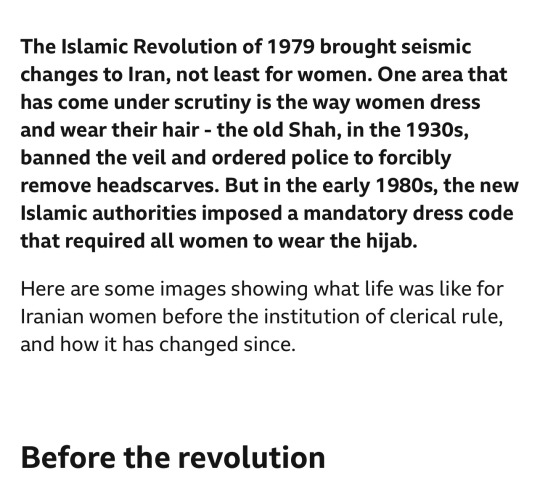

Studying at Tehran University in 1977: While many women were already in higher education at the time of the revolution, the subsequent years saw a marked increase in the number attending university. This was in part because the authorities managed to convince conservative families living in rural areas to allow their daughters to study away from home.
"They tried to stop women from attending university, but there was such a backlash they had to allow them to return," says Baroness Haleh Afshar, a professor of women's studies at the University of York who grew up in Iran in the 1960s.
"Some educated people left Iran, and the authorities realised in order to run the country they needed to educate both men and women."
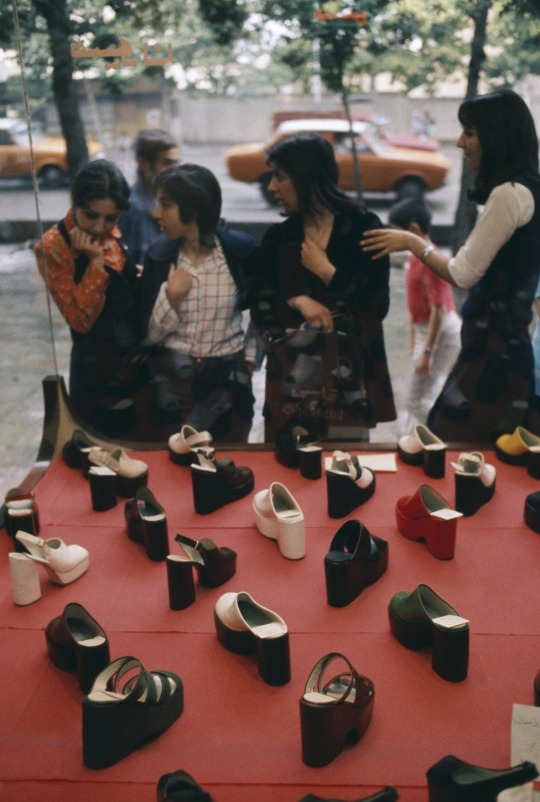
Window shopping in Tehran in 1976: Before the revolution, the hijab was already widely worn but many women also chose to don Western-style clothes, including tight-fitting jeans, miniskirts and short-sleeved tops. "The shoes haven't changed - and the passion for shoes is in all of us! Women in Iran are no different from women the world over, and going shopping is just a means for women to get away from every day stress," says Prof Afshar.
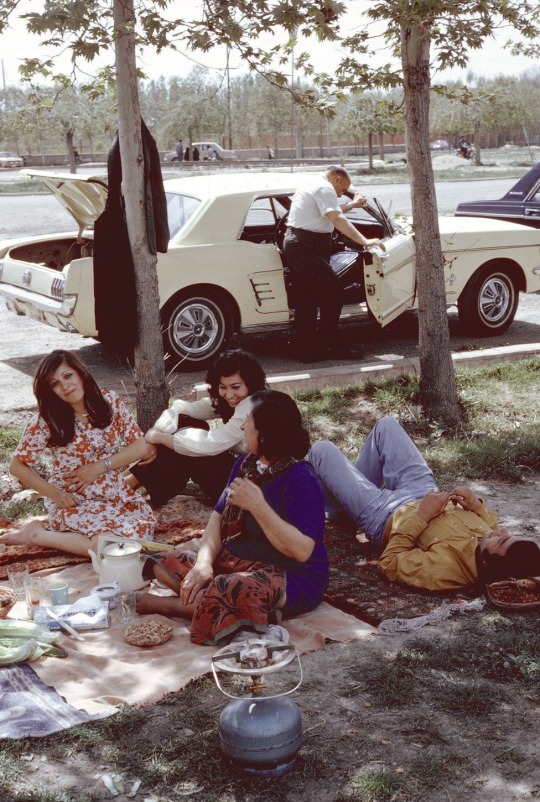
Friday picnic in Tehran in 1976: Families and friends tend to get together on Fridays, which are weekend days in Iran. "Picnics are an important part of Iranian culture and are very popular amongst the middle classes. This has not changed since the revolution. The difference is, nowadays, men and women sitting together are much more self-aware and show more restraint in their interactions," says Prof Afshar.
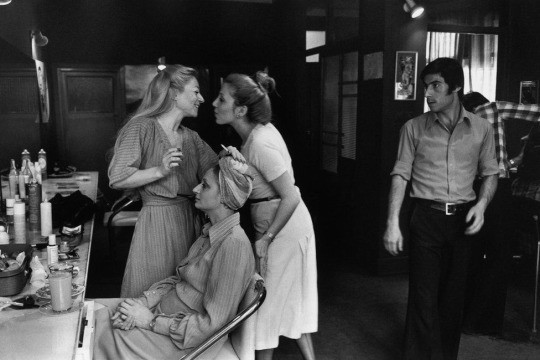
Hair salon in Tehran in 1977: "This is a scene you would no longer expect to see in Iran - but even after the Islamic Revolution, hairdressers continued to exist," says Prof Afshar. "Nowadays you wouldn't see a man inside the hairdressers - and women would know to cover up their hair as soon as they walked out the door. Some people may also operate secret salons in their own homes where men and women can mix."
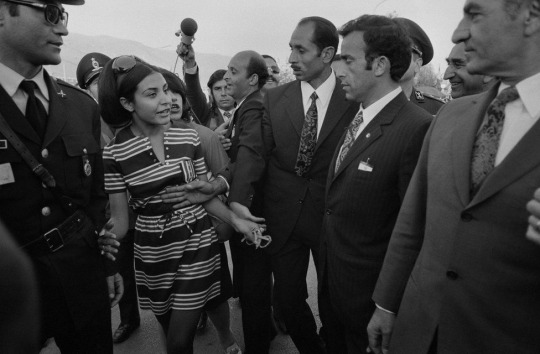
Bodyguards surround the shah in 1971: A young woman approaches Shah Mohammad Reza Pahlavi (far right) at a huge party marking the 2,500th anniversary of the Persian monarchy - the extravagance of the event was widely condemned by his left-wing and clerical opponents. "By this time, the shah was already very much disliked and some believe this image of excess and indulgence may have contributed to events leading up to the revolution eight years later," Prof Afshar explains.

Walking down a snowy street in Tehran in 1976: "You cannot stop women walking in the streets of Iran, but you wouldn't see this today - her earrings and make up so clearly on show," Prof Afshar says. "There is this concept of 'decency' in Iran - so nowadays women walking in the streets are likely to wear a coat down to her knees and a scarf."
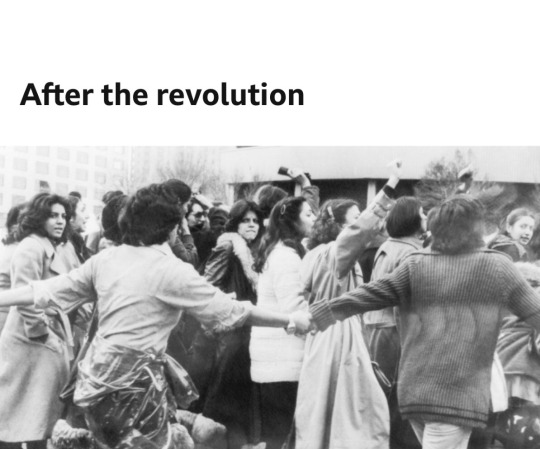
Women rally against the hijab in 1979: Soon after taking power, Iran's new Supreme Leader Ayatollah Ruhollah Khomeini decreed that all women had to wear the veil - regardless of religion or nationality. On 8 March - International Women's Day - thousands of women from all walks of life turned out to protest against the law.
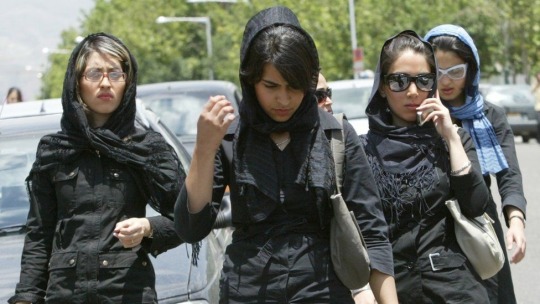
Walking in Tehran in 2005: Not all women in Iran opt to wear the black chador, a cloak that covers the body from head to toe and only leaves the face exposed. Many prefer to wear loosely fitted headscarves and coats. "The real question is how far back do you push your scarf? Women have their own small acts of resistance and often try as far as possible to push their scarves back," says Prof Afshar.

Watching football from a Tehran shopping centre in 2008: Though women were never officially banned from watching men's football matches in Iran, they are often refused entry to stadiums and some of those who have tried have been detained. Before the revolution, women were allowed to attend sporting events.
SEPTEMBER 2022: Protests, after the Morality Police beat, arrested and then murdered Mahsa Amini — for the “crime” of improperly wearing her hijab (source) (source)
#mahsa amini#jini emini#jini amini#iran#hijab#morality police#politics#islamic revolution#tehran#protests#bodily autonomy#womens rights#feminism#womanism#war on women#patriarchy#jhina emini
4K notes
·
View notes
Text
Why Isn’t Every Year the Warmest Year on Record?
This just in: 2022 effectively tied for the fifth warmest year since 1880, when our record starts. Here at NASA, we work with our partners at NOAA to track temperatures across Earth’s entire surface, to keep a global record of how our planet is changing.
Overall, Earth is getting hotter.
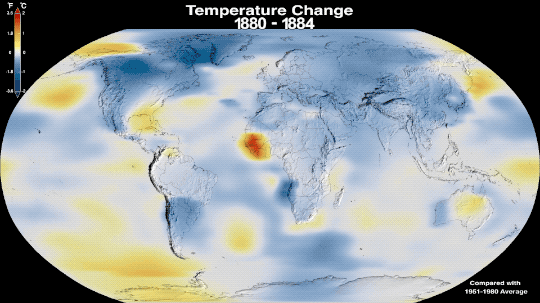
The warming comes directly from human activities – specifically, the release of greenhouse gases like carbon dioxide from burning fossil fuels. We started burning fossil fuels in earnest during the Industrial Revolution. Activities like driving cars and operating factories continue to release greenhouse gases into our atmosphere, where they trap heat in the atmosphere.

So…if we’re causing Earth to warm, why isn’t every year the hottest year on record?
As 2022 shows, the current global warming isn’t uniform. Every single year isn’t necessarily warmer than every previous year, but it is generally warmer than most of the preceding years. There’s a warming trend.
Earth is a really complex system, with various climate patterns, solar activity, and events like volcanic eruptions that can tip things slightly warmer or cooler.
Climate Patterns
While 2021 and 2022 continued a global trend of warming, they were both a little cooler than 2020, largely because of a natural phenomenon known as La Niña.
La Niña is one third of a climate phenomenon called El Niño Southern Oscillation, also known as ENSO, which can have significant effects around the globe. During La Niña years, ocean temperatures in the central and eastern Pacific Ocean cool off slightly. La Niña’s twin, El Niño brings warmer temperatures to the central and eastern Pacific. Neutral years bring ocean temperatures in the region closer to the average.
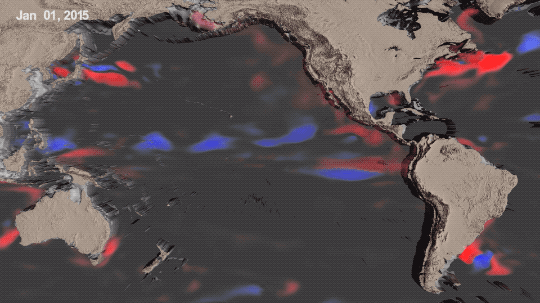
El Niño and La Niña affect more than ocean temperatures – they can bring changes to rainfall patterns, hurricane frequency, and global average temperature.
We’ve been in a La Niña mode the last three, which has slightly cooled global temperatures. That’s one big reason 2021 and 2022 were cooler than 2020 – which was an El Niño year.
Overall warming is still happening. Current El Niño years are warmer than previous El Niño years, and the same goes for La Niña years. In fact, enough overall warming has occurred that most current La Niña years are warmer than most previous El Niño years. This year was the warmest La Niña year on record.

Solar Activity
Our Sun cycles through periods of more and less activity, on a schedule of about every 11 years. Here on Earth, we might receive slightly less energy — heat — from the Sun during quieter periods and slightly more during active periods.

At NASA, we work with NOAA to track the solar cycle. We kicked off a new one – Solar Cycle 25 – after solar minimum in December 2019. Since then, solar activity has been slightly ramping up.
Because we closely track solar activity, we know that over the past several decades, solar activity hasn't been on the rise, while greenhouse gases have. More importantly, the "fingerprints" we see on the climate, including temperature changes in the upper atmosphere, don't fit the what we'd expect from solar-caused warming. Rather they look like what we expect from increased greenhouse warming, verifying a prediction made decades ago by NASA.
Volcanic Eruptions
Throughout history, volcanoes have driven major shifts in Earth’s climate. Large eruptions can release water vapor — a greenhouse gas like carbon dioxide — which traps additional warmth within our atmosphere.
On the flip side, eruptions that loft lots of ash and soot into the atmosphere can temporarily cool the climate slightly, by reflecting some sunlight back into space.
Like solar activity, we can monitor volcanic eruptions and tease out their effect on variations in our global temperature.
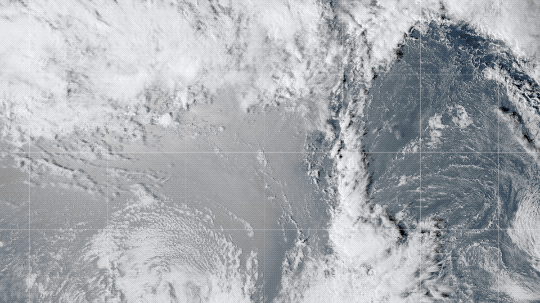
At the End of the Day, It’s Us
Our satellites, airborne missions, and measurements from the ground give us a comprehensive picture of what’s happening on Earth every day. We also have computer models that can skillfully recreate Earth’s climate.
By combining the two, we can see what would happen to global temperature if all the changes were caused by natural forces, like volcanic eruptions or ENSO. By looking at the fingerprints each of these climate drivers leave in our models, it’s perfectly clear: The current global warming we’re experiencing is caused by humans.
For more information about climate change, visit climate.nasa.gov.
Make sure to follow us on Tumblr for your regular dose of space!
3K notes
·
View notes
Text
This series of four videos on Ukraine and the Russia-Ukraine conflict is very interesting. The first is basically just a narrative political history of Ukraine from about 2000 to 2014, talking about different political factions that were relevant in the country in the period, and how different internal and external pressures shaped politics. It's very helpful for understanding the Ukrainian political context, including just how recent and just how shallow the supposed tensions between monolingual Russian and bilingual Ukrainian-Russian speakers was in 2014.
The second video is an overview of the Donbass war from 2014-2022, which you might have been vaguely paying attention to at the time. But it's very helpful to have it all laid out in chronological order with the benefit of hindsight, especially due to the obfuscation of Russian operations at the time that made it hard to work out what, exactly, was going on. It's a combination of a good old 19th century-style filibuster (the military expedition, not the parliamentary maneuver), Fox News-style propaganda, and some (rather badly failed) attempts at astroturfing civil unrest--why Russia thought that would work becomes important in Part 4.
Part 3 is just an extended argument that NATO expansion is not relevant to the 2022 invasion of Ukraine, and while I already agreed with that assessment, it's nice to have it laid out in detail. The very very short version is that by NATO's own public criteria, Ukraine was simply not a candidate to join NATO, and had given up on joining NATO, and that had been painfully obvious since at least the Obama administration. Even more frustratingly, there were multiple points where Russia had an offramp to escalation, where it had gotten everything it could have possibly wanted from the conflict in Donbass, and it refused them all.
Part 4 is the author's attempt to explain why it refused them. The very short explanation is that Russia's government is led by idiots, who are very enamored of a flavor of conspiracy theory that has its origins in the LaRouche movement, and which has been bubbling in both left-wing and right-wing circles since 2000. In this worldview, the US government acting through the CIA (or the British royal family, or George Soros, or Jewish bankers, or whoever your bogeyman of choice is) has an almost supernatural ability to overthrow any government on earth by funding performance art groups (seriously), civil society NGOs, and protestors, and that almost every revolution, actual or so-called, since 1989 has been their direct work, from the post-Soviet revolutions, to Euromaidan, to the Arab Spring.
This belief, in its more overt or fragmentary forms, is incredibly popular, spurred on no doubt by historical instances of CIA malfeasance and actual aggressive wars waged by the Bush administration. But the problem is, it's bunk. During Russia's initial moves against Ukraine in 2014, they tried essentially the same playbook in the Donbass, and of course it failed miserably--you cannot actually astroturf a popular uprising. (The CIA has preferred to stage coups and assassinations, which are a different animal from color revolutions.) The separatists in the Donbass eventually had to be supported by a few thousand Russian troops and direct military aid.
But Putin, driven by his own paranoid misunderstanding of world events, the clique of yes-men he has embedded himself in, and his fear of gay Nazi Jewish CIA agents, simply got Russia in over its head. There is no offramp because Russia cannot articulate what its goals are, and because "stop trying to use George Soros to overthrow the Russian government" is not something the US can agree to, since they are not doing it. The only thing that might have prevented Putin fucking with Ukraine in the first place was maybe if rigging the parliamentary election in 2011 hadn't resulted in protests, in which Putin saw the specter of the hand of the CIA--but of course the US and NATO and the EU had nothing to do with that!
And to cap it all off, since the 2010s the LaRouche movement and its theory of color revolutions has been making inroads in China, so we have that to look forward to in coming decades.
274 notes
·
View notes
Text
So what is going on in Iran right now?
I am pretty sure most of you who are either on TikTok or keep up with international news have heard about the massive protests happening in Iran right now. Its a pretty big deal. But what exactly are these protests for and why are they so important?
Hopefully, for those who dont know whats going on I can explain it all here.
Who is Mahsa Amini and what happened to her
Mahsa Amini was a 22-year-old woman traveling from Kurdistan to Tehran (the capital of Iran) to visit family and was stopped once she entered the city by something called “the morality police” (yes this is a real thing). They claimed Mahsa Amini was wearing her Hijab incorrectly and that she would be arrested to undergo “reeducation” at the police station (which would result in her being released after an hour or so). Mahsa’s brother was with her when she was arrested and waited at the station for her to be released.
It is unclear what exactly happened between when Mahsa was arrested and the events of her death (mostly because we do not have any video of these events), but the women detained along with Mahsa reported for similar offenses reported Mahsa was violently beaten by said “morality officers”. This was supposedly for resisting their insults directed toward her. This story is corroborated by her brother’s report of Mahsa having bruises all over her body and the hospital where Mahsa was staying reporting she was brain dead upon arrival along with reporting signs of skull fracture and bleeding in her brain both on social media and in leaked medical reports.
Mahsa died of her injuries 2 days after she was admitted to the hospital on September 16th of 2022.
The official cause of death as reported by both the morality police and Iranian government has been extremely suspicious since the ‘official’ story claims she died as a result of a random heart attack/seizure combo. However, as stated before, there is plenty of evidence that Mahsa was violently attacked which includes (but is not limited to): the skull fractures found, the bruising around her body and face, the bleeding found in her brain and ears, and the fact several other witnesses have either said they witnessed the assault or have seen the previous things. Mahsa’s father also reported she was in perfect health and did not have a history of heart or seizure issues.
Why are people protesting?
For the people of Iran, instances of violence like this are not an unheard-of occurrence. Since the revolution of 1979 and the creation of this “morality police force” women were forced to wear the Hijab regardless of personal choice and had to adhere to a strict modest dress code lest they face similar treatment to Mahsa. To quote an actual penal code enacted in Iran post-revolution:
"women who appear in public without religious hijab will be sentenced to whipping up to 74 lashes"
Violence against women for this reason was now, in a way, much more normalized. Some of these dresscodes did apply to men, sure, but they were primiarly created expressly to control women with the use of fear and force by way of the Hijab. To also directly quote Iran’s Supreme Leader Ali Khamenei (who has been in power since 1989):
"improperly veiled women should be made to feel unsafe"
Is this an anti-Islam protest?
The protests surrounding the death of Mahsa Amini have definitely gained international attention by what many people are doing in them. Many women are burning their hijabs in the streets, cutting off/shaving their hair, and otherwise just doing a lot of things that, traditionally, would be considered taboo under this system that's currently in place. However, this does not seem to be a direct rejection of Islam and rather a direct rejection of control over women by the use of the Hijab as an avenue for that control.
As stated before, this is not a new issue. There have been anti-hijab protests going on since the revolution in Iran back in the 70s. There were even protests pre-revolution FOR veiling since the leader at the time wanted to strictly stick to western norms. Iran shifted from one major extreme to the other. And in both these extremes choice on the part of the woman in question is completely taken out of the equation. It has been men making these choices for women in a broad universal way without giving women the ability to decide what they want for themselves. There is more than 1 way to veil in Islam. There are also many women who do not veil at all but are still active participants in their faith. There is not one specific way to do this correctly within Islam because modesty as a whole is a subjective topic. So the fact this police force exists in the first place is less about keeping morals ‘secure’ and more about exerting control through these rules via more extreme interpretations.
It would however be unfair to say that these protests and the cultural revolution happening because of these protests do not diametrically oppose some parts of Islam and the culture surrounding it. These beliefs are incompatible by virtue of them being polar opposites of each other. These protests, like it or not, have western influence on them and this influence threatens certain parts of Islam because over time certain aspects of culture have become rooted in these controlling methods. Its pretty unclear how this will all play out. However, it is safe to say this will be shaking up things both within Iran and in the world of Islam as a whole.
Why are Non-Iranian women also cutting their hair?
Ever since the protests have gained international attention many women outside of Iran (both ethnically Iranian and not) have also been cutting their hair to various degrees to stand in solidarity with protestors.
This is significant symbolically for a few reasons. In many cultures, long hair is directly tied to one's femininity, attractiveness, and even in some cases where one comes from. Like it or not hair is culturally and socially important and the loss off it can be a very big deal for those living under these cultural expectations. In Iran doing something like this subjects you to harassment from the morality police. It breaks the morality code and challenges the idea of what a woman should be and look like. Outside of this context, the removal of hair can be a sign of mourning, fear, anger, and a rejection of femininity (or in this case, the control brought on by strict gendered dress codes).
There has been a lot of controversy around this act since many people currently participating in these protests feel this act is performative activism on the part of western allies. Cutting one's hair is not really on the same level as donating money to a cause or protesting yourself. But others believe this is an important act of international solidarity. If you reading this decide to do this: do it at your own discretion and be sure your act of solidarity does not outshine the actual protests going on.
Why are people asking to blur/delete protest footage posted online?
It should go without saying that the people protesting right now are putting themselves in very real danger. What happened to Mahsa Amini is now happening to protesters who are speaking out about Iran’s harsh morality laws. Many people have died already as a result of participating in these protests and many more have gone missing. When you are dealing with an oppressive system like this they are not going to take too kindly to opposition. And if they are not afraid to beat women simply for wearing their Hijab ‘incorrectly’, they are not afraid to do much worse to political rivals.
Out of respect for the protesters and their safety: please blur out any faces, names, and remove all metadata from any protest photos/footage you decide to share online. Because if I can find one of the protestors on Instagram simply by looking at their face and general location so can the morality police. For those around during the Black Lives Matter protests, the Russian anti-war protests, or any other media-sensitive protest use those same rules when posting footage/reporting on them
1K notes
·
View notes
Text
🚨🚨URGENT: ANOTHER Death Sentence Issued in Iran🚨🚨
Jamshid Sharmahd, an Iranian-German national, has been sentenced to death. The picture used in the article from IranWire alone is enough to break your heart. What's especially disturbing about his case are the circumstances surrounding his death: He was kidnapped while in Dubai and was subjected to extremely cruel treatment during imprisonment. The legitimacy of the accusations against him are dubious, and there's no telling whether an appeal will have any effect. Please be his voice. Say his name and save his life.
SOURCE
#stop executions in iran#iran revolution#iran protests#iran revolution 2022#iran revolution 2023#woman life freedom#women life freedom#iran protests 2023#free iran#freedom for iran#human rights#iran protests 2022#current events#social justice
52 notes
·
View notes
Text
Fun With Jump Arm Variations
When jumping, different skaters put their arms in different places, but generally they are pressed flat against the torso, especially on higher-revolution jumps. This compressed shape increases the skater’s rotational speed, which is important for attempting triples and quads.
But as anyone who has watched much skating has seen, you can jump with your arms in different positions, too. There are two main arm variations you will see in modern skating programs:
One arm above the head - these are nicknamed ‘tanos’ after Brian Boitano, who did not invent but did popularize the variation. Ones where the arm is bent a lot may be derisively nicknamed ‘helicopter tanos’, as some fans don’t like how they look. (Brian Boitano 1988 Olympics SP, Brian Orser 1988 Olympics SP, Petra Burka 1965 FS, Wendy Burge 1976 Olympics FS, Ekaterina Kurakova 2022 Euros FS)


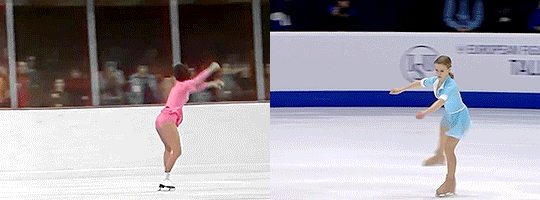
Two arms above the head - these are nicknamed ‘rippons’ after Adam Rippon, who also did not invent them but popularized them when he started doing it on his lutz. (He did tanos on it for a while, but then started using both arms when he trained with Brian Orser, because he felt bad doing ‘tanos’ in front of Orser, who famously took silver behind Boitano at the Olympics.) (Adam Rippon 2016 GP France FS, Midori Ito 1988 Olympics SP, Ting Cui 2018 JGP Ostrava SP, Sihyeong Lee 2021 Nebelhorn FS)


However, there are also other arm variations. These are all rare nowadays, although if you watch older programs, you are more likely to spot a variation that’s not a tano or rippon. Ones I’ve seen include:
Hands on hips - these used to be much more popular back in the day but have fallen out of fashion. I would guess it’s because they slow down rotational speed too much, as every one I have seen is a double except this one by Michael Chack, but I don’t know for sure. (Jill Trenary 1990 Worlds FS, Michael Chack 1992 USNats FS, Rory Flack 1988 USNats SP, Tonia Kwiatkowski 1988 USNats SP, Midori Ito 1987 Worlds SP, Anna Kondrashova 1988 Olympics SP, Yuzuru Hanyu 2010 JPNats FS)




Helicopter arms - this one has been used as a warm-up by Yuzuru Hanyu, and I’ve spotted it in competitions a couple of times with single and double jumps (Rory Flack 1994 US Open Artistic Program, Yuzuru Hanyu 2012 Finlandia Trophy SP warmup)

Arms behind back - I’ve only seen this one performed by Jason Brown in his Riverdance program, where depending on the event he placed either one or both arms behind his back during the second jump of this combo (2013 SA FS, 2014 Nats FS)

Arm switching midair - I’ve only seen this one in this lovely axel variation by John Curry (1976 Olympic SP)
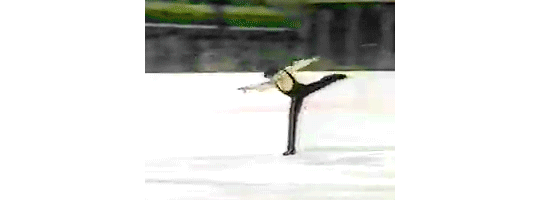
Hands by the head - I believe I may have seen this used by at least one other skater, but the only example I have at hand is this one by Nancy Kerrigan (1990 Goodwill Games SP)

Beginning in 2009, ‘varied position in the air’ became a positive GOE bullet point for jumps. This was because they are supposed to add to the difficulty of a jump, although I’ve seen arguments back and forth from skaters about how true that is for some arm positions (and even if which arm is raised makes a difference for tanos). Years later, they exploded in popularity, particularly in the women’s competition. The trend had its beginning around 2014 or so; the previous season, junior World medalists Evgenia Medvedeva and Serafima Sakhanovich were given programs constructed to include raised arms on a couple of jumps, which wasn’t too unusual, but in 2014, their programs contained many more of them. Medvedeva would go on to dominate the senior circuit for several years and notably used raised arms on most of her jumps during that time, which started the trend in earnest among other skaters.
This GOE bullet point was removed for the 2018-2019 season. But if arm variations no longer get that bit of GOE, why do we still see them so often? There are probably a few reasons:
Skaters who trained them for GOE a few years ago got used to doing them that way and don’t want to mess with their muscle memory
They can add to a program aesthetically
Skaters and their teams may still hope to impress the judges by using them
Skaters have said that rippons help straighten their jump axis
I’ve also seen speculation that rippons can be used to help muscle jumps using the upper body in some cases
I would also like to shout out arm variations on jump exits that aren’t the standard check-out position. These aren’t as common as mid-air variations nowadays and rarely get talked about as their own thing - probably in part because they were never a GOE bullet - but they can add difficulty to the exit as well as give a nice choreographic touch to a program. You can see a few in the above gifs, but here’s a few more:

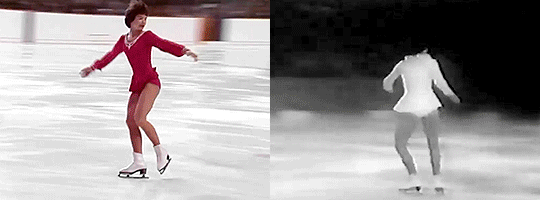


(Petra Burka 1965 Worlds FS, Yuzuru Hanyu 2021 “White Nights” EX, Anett Pötzsch 1976 Olympics FS, Hana Mašková 1968 Worlds FS, Claudia Kristofics-Binder 1976 Olympics FS, Brian Boitano 1988 Olympics SP, Vladimir Kovalyov 1976 Olympics SP)
#figure skating#fskateedit#fs history#Yuzuru Hanyu#Midori Ito#Brian Orser#Brian Boitano#Jason Brown#John Curry#Adam Rippon#Rory Flack#Ekaterina Kurakova#gifs#I went kind of crazy on the gifs here#long post
186 notes
·
View notes
Text
A little KaixBecky to celebrate the end of Mayblade. It’s been a wild ride, but I’ve absolutely loved it. Looking forward to sharing what I’ve worked on with some NSNV updates soon!

#mayblade 2022#kai hiwatari#becky carter#beybladeseason4#beyblade event#beyblade g revolution#kaixoc
4 notes
·
View notes
Link
Two founding members of the Soviet Union — Russia and Ukraine — are once again in conflict. Here are some pivotal moments in the years leading up to Moscow’s decision to invade the country on Feb. 24, as well as a brief look at relations between Russia and Ukraine in the 20th century.
2014 — Protesters in Ukraine overthrow President Viktor Yanukovych in February. He had been friendly to Russia’s interests. During the revolution, more than 100 people are killed in protests that centered on the main square in the capital Kyiv, often called the Maidan.
The interim government that followed this pro-Western revolution eventually signs a trade agreement with the European Union that is seen as a first step toward membership of the bloc.
Russia annexes the Crimean Peninsula. Two secessionist regions, the Donetsk People’s Republic and the neighboring Luhansk People’s Republic, later break off from Ukraine.
The war continues in the eastern Ukrainian region known as Donbas. It then spreads west. Roughly 13,000 Ukrainian soldiers and civilians eventually die in the conflict. The front lines have barely shifted for years.
2014 and 2015 — Russia, Ukraine, France and Germany sign a series of cease-fire agreements known as the Minsk Accords. Many view these accords as ambiguous.
April 2019 — A former comedian, Volodymyr Zelensky, is elected by a large majority as president of Ukraine on a promise to restore Donbas to the country.
2021-2022 — President Vladimir V. Putin of Russia seeks to prevent Ukraine’s drift toward the United States and its allies. Mr. Putin demands “security guarantees,” including an assurance by NATO that Ukraine will never join the group and that the alliance pulls back troops stationed in countries that joined after 1997.
Many Russians view the Ukrainian capital, Kyiv, as the birthplace of their nation and cite the numerous cultural ties between the two countries.
Here is a brief recap of their relations in the 20th century:
1918-1922 — Ukraine declares independence in 1918 during a conflict fought by multiple countries and armies over several years. Its independence and sovereignty receive international recognition that year at the Treaty of Brest-Litovsk. Soviet forces work to overthrow independent Ukraine. The Ukrainian Soviet Socialist Republic is founded in 1921 and Ukraine is subsumed into the Soviet Union the following year.
1932 and 1933 — A famine caused by Stalin’s policy of collectivization kills millions of people, mainly ethnic Ukrainians in a country that is known as the bread basket of the Soviet Union. The disaster is known as the Holodomor.
1939-1944 — The Soviet Union annexes Western Ukraine. Later, Nazi Germany and the Axis powers occupy the country during World War II. Throughout the period Ukraine suffers devastation.
1991 — The Soviet Union is terminated via a treaty. Ukraine becomes independent and begins a transition to a market economy. It also comes into possession of a significant stockpile of nuclear weapons that had belonged to the Soviet Union.
1994 — Under the Budapest Memorandum, Ukraine gives up its nuclear arsenal in exchange for a commitment from Moscow “to respect the independence and sovereignty and the existing borders of Ukraine.”
#current events#history#military history#russo-ukrainian war#2022 russian invasion of ukraine#revolution of dignity#annexation of crimea by the russian federation#war in donbas#minsk agreements#ukrainian war of independence#treaty of brest-litovsk#holodomor#ww2#budapest memorandum#ukraine#russia#ussr#viktor yanukovych#volodomyr zelensky
0 notes
Photo

HENRY— snippet The first book under themarbleeyelids on Archive of Our Own (AO3) is finally being drafted, and I’m so excited to share it with you all soon. This story has been in the works since I first discovered Casey McQuiston’s beloved novel, Red, White, and Royal Blue May of 2022. Her novel gave me so much hope and happiness as a reader that I returned to my own words as a writer. ••••••• As per the title, Henry will follow Prince Henry George Edward James Fox-Mountchristen-Windsor’s (Henry Fox, for short) life one year following the events of RWRB. Alex has since graduated from Georgetown and is now studying Law at NYU. While Henry is supporting Percy as a grant writer for his new LGBTQIA+ non-profit in Brooklyn. From the outside, both Alex and Henry are doing great, despite the media’s never ending obsession with the Waterloo letters and despite Henry’s grandmother managing to breathe down their neck an ocean away. Nonetheless, as Henry’s brother becomes sick with an unknown illness and Henry temporarily steps in to fill his brother’s duties, the weight of the crown begins to take its toll on Henry’s shoulders. As Henry begins to crack under the pressure, secrets about Henry’s mental health slip through causing a revolution that very well may change the nature of Alex and Henry’s relationship and the delicate balance of both U.K. and U.S. politics, alike. "Uneasy lies the head that wears the crown."
#fanfictionauthor#nanowrimo#red white and royal blue#henry fox mountchristen windsor#rwrb#prince henry rwrb#rwrb movie#alex claremont diaz#casey mcquiston#indieauthor#archive of our own#ao3 writer#lgbtq community#lgbtq literature#ableism#mental health#nicholas galitzine#taylor zakhar perez
55 notes
·
View notes